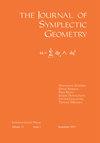Epsilon-non-squeezing and $C^0$-rigidity of epsilon-symplectic embeddings
IF 0.4
3区 数学
Q3 MATHEMATICS
引用次数: 3
Abstract
An embedding $\varphi \colon (M_1, \omega_1) \to (M_2, \omega_2)$ (of symplectic manifolds of the same dimension) is called $\epsilon$-symplectic if the difference $\varphi^* \omega_2 - \omega_1$ is $\epsilon$-small with respect to a fixed Riemannian metric on $M_1$. We prove that if a sequence of $\epsilon$-symplectic embeddings converges uniformly (on compact subsets) to another embedding, then the limit is $E$-symplectic, where the number $E$ depends only on $\epsilon$ and $E (\epsilon) \to 0$ as $\epsilon \to 0$. This generalizes $C^0$-rigidity of symplectic embeddings, and answers a question in topological quantum computing by Michael Freedman. As in the symplectic case, this rigidity theorem can be deduced from the existence and properties of symplectic capacities. An $\epsilon$-symplectic embedding preserves capacity up to an $\epsilon$-small error, and linear $\epsilon$-symplectic maps can be characterized by the property that they preserve the symplectic spectrum of ellipsoids (centered at the origin) up to an error that is $\epsilon$-small. We sketch an alternative proof using the shape invariant, which gives rise to an analogous characterization and rigidity theorem for $\epsilon$-contact embeddings.辛嵌入的非挤压和C^0$刚性
如果与$M_1$上的固定黎曼度规的差$\varphi^* \omega_2 - \omega_1$为$\epsilon$ -小,则嵌入$\varphi \colon (M_1, \omega_1) \to (M_2, \omega_2)$(相同维数的辛流形)称为$\epsilon$ -辛。我们证明了如果一个$\epsilon$ -辛嵌入序列(在紧子集上)一致收敛到另一个嵌入,那么极限是$E$ -辛的,其中$E$只依赖于$\epsilon$和$E (\epsilon) \to 0$作为$\epsilon \to 0$。这概括了辛嵌入的$C^0$ -刚性,并回答了Michael Freedman在拓扑量子计算中的一个问题。在辛的情况下,刚性定理可以从辛容量的存在性和性质中推导出来。$\epsilon$ -辛嵌入将容量保留到$\epsilon$ -小误差,线性$\epsilon$ -辛映射的特征是它们保留椭球(以原点为中心)的辛谱,误差为$\epsilon$ -小。我们用形状不变量勾画了另一种证明,它产生了$\epsilon$ -接触嵌入的类似表征和刚性定理。
本文章由计算机程序翻译,如有差异,请以英文原文为准。
求助全文
约1分钟内获得全文
求助全文
来源期刊
CiteScore
1.30
自引率
0.00%
发文量
0
审稿时长
>12 weeks
期刊介绍:
Publishes high quality papers on all aspects of symplectic geometry, with its deep roots in mathematics, going back to Huygens’ study of optics and to the Hamilton Jacobi formulation of mechanics. Nearly all branches of mathematics are treated, including many parts of dynamical systems, representation theory, combinatorics, packing problems, algebraic geometry, and differential topology.

 求助内容:
求助内容: 应助结果提醒方式:
应助结果提醒方式:


